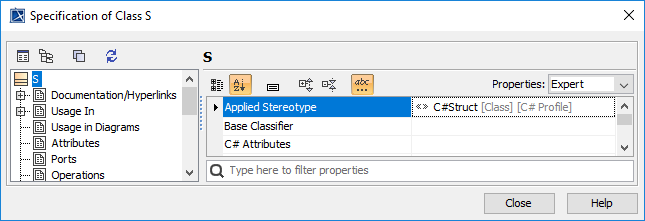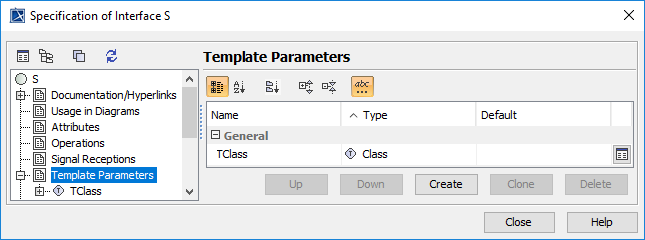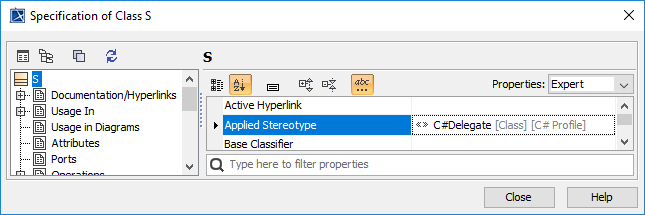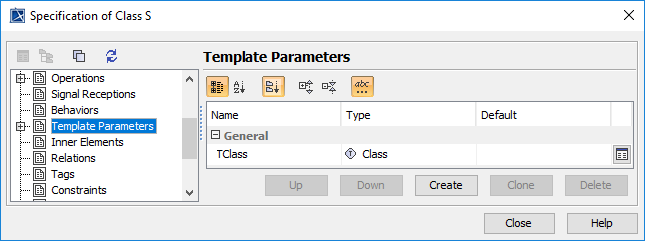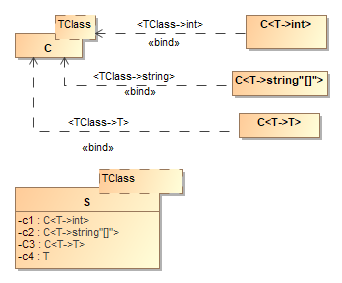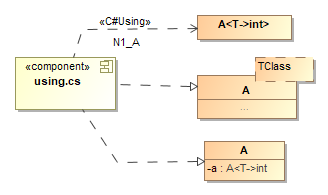Generics permit classes, structs, interfaces, delegates, and methods to be parameterized by the data types they store and manipulate. Generic class declaration should be mapped to the UML classifier (class or interface) with a Template parameter. Additionally, Generics still affect other parts of the program structures such as Attribute, Operation, Parameter, Parent Class, and Overloading Operators. In this chapter you will find how C# code structures are mapped to the UML model.
Generic Class
Class S has one template parameter named T. The default type of T is Class.
Example
Code:
public class S<T>
{
}
Reversed UML model:
Generic Struct
The type parameter of generic struct is created the same as generic class, but we apply «C#Struct» stereotype to the model.
Example
Code:
public class S<T>
{
}
Reversed UML model:
Sample: Class S with applied stereotype C#Struct
Generic Interface
Example
Code:
interface S<T>
{
}
Reversed UML model:
Sample: Interface S template parameters
Generic Delegate
To create a generic delegate, we create a class model and apply the «C#Delegate» to the model. We, then, create an empty named method with delegate return type, and add template parameter like a normal generic class.
Example
Code:
delegate string D<T>();
Reversed UML model:
Sample: Applied Stereotype is C#Delegate
Sample: Template parameters
Generic Attribute
The type of attributes in the class can be generic binding (template binding) or template parameter of owner class. The example code shows attributes that use template binding as its type
Example
Code:
class C<T>
{
}
class D<T>
{
private C<int> c1;
private C<string[]> c2;
private C<T> c3;
private T c4;
}
Reversed UML model:
Class D Attributes with generic type
The following shows how Template binding for C<int> is created:
- From the Template binding link shortcut menu, select Specification.
- From Specification window property group list, select Template parameter Substitutions property group.
- Enter Actual property value as datatype int.
Template binding for C<int>
Code:
.. Private C<int> c1;
Reversed UML model:
Creating Template binding for C<string[]>:
- From the Template binding link shortcut menu, select Specification.
- From Specification window property group list, select Template parameter Substitutions property group.
- Enter Actual property value as datatype string.
Template binding for C<string[]>
Code:
.. Private C<string[]> c2;
Reversed UML model:
Creating Template binding for C<T>:
- From the Template binding link shortcut menu, select Specification.
- From Specification window property group list, select Template parameter Substitutions property group.
- Enter Actual property value as Binding type T. T is the template parameter of its Owner Class S<T>.
Template binding for C<T>
Code:
.. Private C<T> c3;
Reversed UML model:
Creating attribute with the type template parameter of the owner class S<T>:
- Create Attribute c4 (c4 is not a template binding class).
- From the Attribute link shortcut menu, select Specification.
- Specify Type property, select Template parameter of the Owner Class S<T>.
- From Specification window property group list, select Template parameter Substitutions property group.
- Enter Actual property value as datatype int.
Template binding for Attribute c4
Code:
.. Private T c4;
Generic Operation
Language extention Generic can be applied to Operation.
Example
Code:
public class S<T>
{
public void f1<T>() {}
}
Reversed UML model:
To create Generic Operation, open the operation Specification window, and from Property group createTemplate Parameters.
To create Operations with parameters and return type, create them like a Generic Attribute.
Binding Types
In the example code, the type of parameter t is public void f1<T> (T t), it must be the Template Parameter of the owner method, but type f1<T> is not the template parameter of the owner Class S<T>.
In the second method, public void f1<U, V> (T t, U u), parameter t type must be the Template Parameter of the owner Class, S<T>.
Example
Code:
public class S<T>
{
public void f1<T> (T t)
{
}
public void f1<U, V> (T t, U u)
{
}
}
Reversed UML model:
Example
Code:
class b
{
public T f1<T, U>(T t, U u)
whereU:T{returnt; }
}
Reversed UML model:
Generic overloading
Methods, constructors, indexers, and operators within a generic class declaration can be overloaded. While signatures as declared must be unique, it is possible that substitution of type arguments results in identical signatures.
Example
Code:
class X<T>
{
public static explicit operator X<T>(T value)
{ return null; }
public static implicit operator T(X<T> x)
{ return x.item; }
public static explicit operator
XXX<int>(X<T> x)
{ return null; }
public static explicit operator
X<T>(XXX<int> x) }
{ return null; }
public static X<T> operator ++(X<T> operand)
{ return null; }
public static int operator >>(X<T> i, int c)
{ return c; }
}
Reversed UML model:
Generic parent class
Example
Code:
class b<T, U>
{}
class b1<X> : b<X[], X[,]>
{}
Reversed UML model:
Example
Code:
class b<T, U>
{}
interface Ib<B>
{}
class b2<Y> : b<int?[], string[]>
{}
class c<T> : b<int?, string>
{}
class d<X, Y> : b<X, Y>, Ib<int>
{}
Reversed UML model:
Generic using alias
For example, using N1_A = N1.A<int>, we create Template binding for A<int> in Namespace N1, and then we create the dependency Usage from the parent component (in this case it is file component) to the class with template binding.
Example
Code:
using N1_A = N1.A<int>; namespace N1
{
public class A<T> {}
}
class A
{
N1_A a;
}
Reversed UML model:
Generic constraints
Generic type and method declarations can optionally specify type parameter constraints by including type-parameter-constraints-clauses:
type-parameter-constraints-clause
type-parameter-constraints-clauses type-parameter-constraints-clause
type-parameter-constraints-clause:
where type-parameter : type-parameter-constraints
The list of constraints given in a where clause can include any of the following components, in this order: a single primary constraint, one or more secondary constraints, and the constructor constraint, new().
type-parameter-constraints:
primary-constraint
secondary-constraints
constructor-constraint
primary-constraint , secondary-constraints
primary-constraint , constructor-constraint
secondary-constraints , constructor-constraint
primary-constraint , secondary-constraints , constructor-constraint
A primary constraint can be a class type or the reference type constraint class or the value type constraint struct.
class-type
class
struct
A secondary constraint can be a type-parameter or interface-type:
interface-type
type-parameter
secondary-constraints , interface-type
secondary-constraints , type-parameter
constructor-constraint:
new ( )
Each type-parameter-constraints-clause consists of the token where, followed by the name of a type parameter, followed by a colon and the list of constraints for that type parameter. There can be at most one where clause for each type parameter, and the where clauses can be listed in any order.
The given list of constraints in a where clause can include any of the following components, in this order: a single primary constraint, one or more secondary constraints, and the constructor constraint, new().

